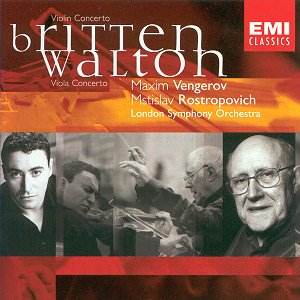This was chosen as Recording of the Month
last month - see review
EMI are to be congratulated on such adventurous
programming, teaming these relatively lesser known concertos.
It would have been so much easier and probably more commercially
appealing to have recorded Walton’s much better known and more
immediately appealing Violin Concerto rather than the one for
Viola. But as Malcolm Macdonald says in
his erudite booklet note, we have the opportunity to compare these
two concertos. Although written ten years apart, they were composed
when the two men were in their early twenties (Britten was, 26;
Walton 25). Both follow a strikingly modern pattern, which had
been used by Prokofiev for his First Violin Concerto of 1916-17.
This broke the tradition of the great Classical and Romantic concertos.
Both concertos follow a similar format: a moderately paced, predominantly
lyrical first movement, a highly rhythmic central scherzo and
a substantial, far lengthier (Britten, 15:10; Walton, 16:23 here)
wide-ranging finale that sums of the argument of the whole work.
Clearly the idea of the
partnership of Maxim Vengerov and Mstislav Rostropovich is a powerful
one. With producer John Fraser in the control room they do not
disappoint. Nice that Fraser gets a prominent credit on the album
after many years of excellent service for EMI supervising so many
excellent recordings.
Britten began work
on his Violin Concerto in 1938 and completed it a few days after
World War II broke out. It was premiered in New York on 29 March
1940 by the Spanish violinist Antonio Brosa, a refugee from Franco’s
regime. The New York Philharmonic Orchestra was conducted by Barbirolli.
Britten had met Brosa in the mid-1930s and had performed with
him in the Barcelona in 1936 shortly before the outbreak of the
Spanish Civil War. Appropriately, Britten uses Spanish rhythms
and spectral hints of flamenco. The frequent restlessness and
harsh voice of the orchestra, with, for example, its persistently
nagging drum rhythm surely reflects the growing international
tension of those days. The violin sings serenely, pacifyingly,
then ultimately in lamentation.. Vengerov’s beautifully refined
and eloquent reading explores depths of emotional involvement
while he shows his usual quicksilver dexterity in the wild sardonic
scherzo. Both conductor and soloist point up the Prokofiev inspiration
of this movement. Throughout, Rostropovich provides a very colourful
and dramatic accompaniment with the orchestral tapestry nicely
balanced and transparent.
It was Sir Thomas Beecham
who suggested, in 1928, that Walton should write a Viola
Concerto for Lionel Tertis. Christopher Palmer commented, "It
was a work of such obvious mastery that it established Walton’s
place in the vanguard of contemporary English music." At
the time, however, Walton confessed that he knew little about
the viola except that it made a rather awful sound! Nevertheless,
he rose to the challenge and completed its composition at Amalfi
south of the Bay of Naples. Alas, Tertis, returned it declaring
it too modern. Understandably, Walton was deeply hurt. However
the German viola player and composer Paul Hindemith agreed to
premiere the Concerto. Tertis later apologized to Walton for having
turned the work down and requested further performances of the
work. In 1961 Walton revised the score reducing the size of the
orchestra using double (rather than triple) woodwind, eliminating
one trumpet and the tuba, but adding a harp. This is heard mainly
in its lower registers to balance the viola adding a gentle anchoring
ostinato, and heard most affectingly in the final Allegro moderato
movement as a lovely ostinato figure. This might suggest lapping-water
and, combined with the brilliant surrounding orchestral texture,
conveys the colour and light of a Mediterranean coastline.
For this recording, Vengerov
uses a Stradivari ‘Archinto’ viola of 1696 lent by the Royal Academy
of Music, London from which he produces the most beautiful tone.
I cannot remember this concerto’s sweet sad lyricism and romantic
yearning more movingly communicated. The mercurial Rondo with
its perky syncopations has attack and brio aplenty. Overall Vengerov
and Rostropovich give a deeply satisfying reading, rising, with
aplomb, to the Concerto’s challenges typified by wide intervals,
looping arabesques, and irregular and syncopated rhythmic patterns.
Memorable and deeply satisfying
performances of two major British string concertos. Unhesitatingly
recommended.
Ian Lace
See also review by
Marc Bridle
